
Fix Excel 2013 formula not showing result | Stellar

[Fix] Excel formula not showing result
Summary: Is your Excel spreadsheet showing text of a formula you’ve entered and not its result? This blog explains the possible reasons behind such an issue. Also, it describes solutions to fix the ‘Excel formula not showing result’ error. You can try Stellar Repair for Excel software to recover engineering and shared formulas.
Sometimes, when you type a formula in a cell of worksheet and press Enter, instead of showing the calculated result, it returns the formula as text. For instance, Excel cell shows:

But you should get the result as:

Why Does Excel Show or Display the Formula Not the Result?
Following are the possible reasons that may lead to the ‘Excel showing formula not result’ issue:
- You accidentally enabled “Show Formulas” in Excel.
- The cell format in a spreadsheet is set to text.
- ‘Automatic calculation’ feature in Excel is set to manual.
- Excel thinks your formula is text (Syntax are not followed).
- You type numbers in a cell with unnecessary formatting.
How to Fix ‘Excel Showing Formula Not Result’ Issue?
Solution 1 – Disable Show Formulas
If only the formula shows in Excel not result, check if you have accidentally or intentionally enabled ‘show formula’ feature of Excel. Instead of applying calculations and then showing results, this feature displays the actual text written by you.
You can use the ‘Show Formulas’ feature to quickly view all formulas, but if you are not aware of this feature, and enabled it accidentally, it can be a headache. To disable this mode, go to ‘Formulas’ and click on ‘Show formula enabled.’ If it’s previously enabled, it will be disabled by just clicking on it.

Solution 2 – Cell Format Set to Text
Another possible reason that only formula shows in Excel not result could be that the cell format is set to text. This means that anything written in any format in that cell will be treated as regular text. If so, change the format to General or any other. To get Excel to recognize the change in the format, you may need to enter cell edit mode by clicking into the formula bar or just press F2.

Solution 3 – Change Calculation Options from ‘Manual’ to ‘Automatic’
There is an “automatic calculation” feature in Excel, which tells Excel to do calculations automatically or manually. If ‘Excel formula is not showing results’, it may be because the automatic calculations feature is set to manual. This issue is not easily detected because it results in calculating formula in one cell but if you copy it to some other cell, it will retain the first calculation and will not recalculate on the base of the new location. To fix this, follow these steps:
- In Excel, click on the ‘File’ tab on the top left corner of the screen.
- In the window that opens, click on ‘Options’ from the left menu bar.
- From ‘Excel Options’ dialog box, select ‘Formulas’ from the left side menu and then change the ‘Calculation options’ to ‘Automatic’ if it’s currently set as ‘Manual’.

- Click on ‘OK’. This will redirect you to your sheet.
Solution 4 – Type Formula in the Right Format
There is a proper way to tell Excel that your text is a formula. If you don’t write the formula in a particular format, Excel considers it as simple text and hence no calculations are performed according to it. For this reason, keep the following in mind when typing a formula:
Equal sign: Every formula in Excel should start with an equal sign (=). If you miss it, Excel will mistake your formula as regular text.
Space before equal sign: You are not supposed to enter any space before equal sign. Maybe a single space will be hard for us to detect, but it breaks the rule of writing formulas for Excel.
Formula wrapped in quotes: You need to make sure that your formula is not wrapped in quotes. People usually make this mistake of writing a formula in quotes, but in Excel, quotes are used to signify text. So your formula won’t be evaluated. But you can add quotes inside formula if required, for example: =SUMIFS(F5:F9,G5:G9,”>30″).
Match all parentheses in a formula: Arguments of Excel functions are entered in parenthesis. In complex cases, you may need to enter more sets of parenthesis. If those parentheses are not paired/closed properly, Excel may not be able to evaluate the entered formula.
Nesting limit: If you are nesting two or more Excel functions into each other, for example using nested IF loop, remember the following rules:
- Excel 2019, 2016, 2013, 2010, and 2007 versions only allow to use up to 64 nested functions.
- Excel 2003 and lower versions only allow up to 7 nested functions.
Solution 5 – Enter Numbers without any Formatting
When you use a number in the formula, make sure you don’t enter any decimal separator or currency sign, e.g. $, etc. In an Excel formula, a comma is used to separate arguments of a function and a dollar sign makes an absolute cell reference. Most of these special characters have built-in functions so avoid using them unnecessarily.
What to Do If the Manual Solutions Don’t Work?
If you’ve tried out the manual solutions mentioned above but still unable to resolve the ‘Excel formula not showing result’ issue, you can try repairing your Excel file with the help of an automated Excel repair software , such as Stellar Repair for Excel.
This reliable and competent software scans and repairs Excel files (.XLSX and .XLS). It also helps recover all the file components, like formulas, cell formatting, etc. Armed with an interactive GUI, this software is extremely easy to work with, and its advanced algorithms allow it to fend off Excel errors with ease.
Conclusion
This blog outlined the possible reasons that may cause ‘Excel not showing formula results’ issue. Check out these reasons and implement the manual fixes, depending on what resulted in the problem in the first place. If none of these fixes help resolve the issue, corruption in the Excel file might be preventing the formulas from showing the actual results. In that case, using Stellar Repair for Excel tool might help.
[Fixed] Excel Cannot Open the File Because the File Format or File Extension Is Not Valid
When opening an older version of an Excel file in a newer version, you may encounter the “Excel cannot open the file because the extension is not valid” error. This happens if you have accidentally renamed the file with a different file format or an incorrect file extension. Also, you may get the ‘Excel cannot open the file’ error if the file has become unreadable or corrupted.
This is how the complete Excel error message looks like:
“Excel cannot open the file filename.xlsx because the file format or file extension is not valid. Verify that the file has not been corrupted and that the file extension matches the format of the file.”

Check out this video for a quick demonstration of how to fix “Excel Cannot Open the File Because the File Format or File Extension Is Not Valid”
How to Fix the ‘Excel Cannot Open the File Because the File Format or Extension Is Not Valid’ Error?
Try any of these workarounds to fix the error and regain access to your Excel file data:
Workaround 1 – Change the Default File Format
By default, an Excel file is saved in .xlsx or .xls file format. Trying to open the file with a different or incorrect extension may cause the ‘Excel cannot open the file because the extension is not valid’ error. To fix the error, try changing the Excel default file format by following these steps:
Note: Take a backup of the Excel file that you cannot open and try the steps on the backup copy.
- In Excel 2010 and newer versions, click on the File menu.
Note: For Excel 2007 and earlier versions, click on the Office button.
- On the left panel, click on Options.
- In ‘Excel Options’ window, under Save workbooks section, click on the Save files in this file format: drop-down. Select a file format (i.e., the one supported by your Excel version).
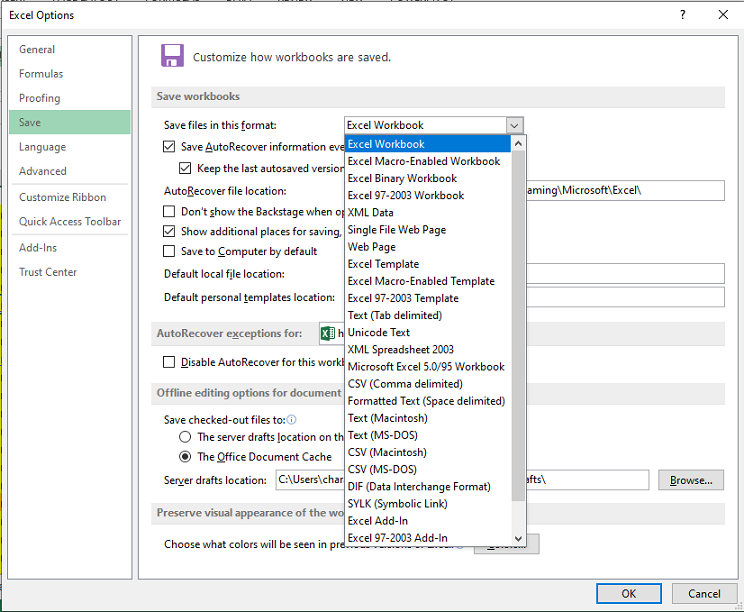
- Click OK.
Check if you can open your Excel file. If not, try the next workaround.
Workaround 2 – Edit the Excel File Permissions
You may receive the ‘Excel file format or file extension is not valid’ error if you lack sufficient permissions to open the file. Usually this happens when you try to open an Excel file received from some other user. Follow these steps to change the file permissions and see if it fixes the problem:
- Right-click on the file that won’t open and click Properties.
- In the file properties dialog box, click the Security tab and then hit the Edit button.
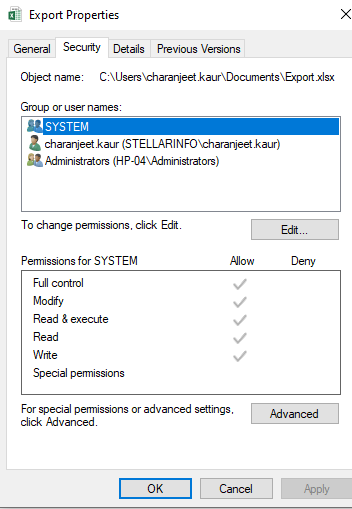
- When the file’s permissions dialog box appears, click on the Add button.
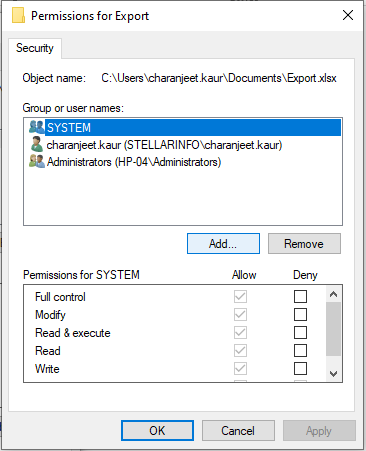
- Click on the Advanced button from the ‘Select Users or Groups’ window.
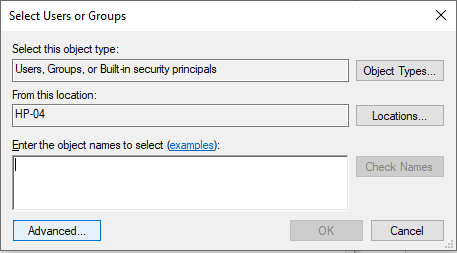
- Select Find Now. A list of all users and groups will get displayed in a search results box. Choose Everyone group from the list and hit OK.
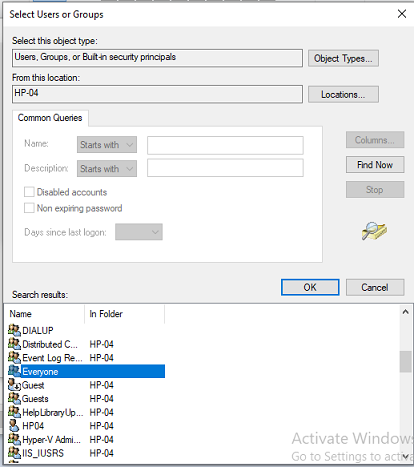
- You can see the ‘Everyone’ group in the ‘Enter the object names to select’ textbox. Click OK once again to return to the file’s permission dialog box.
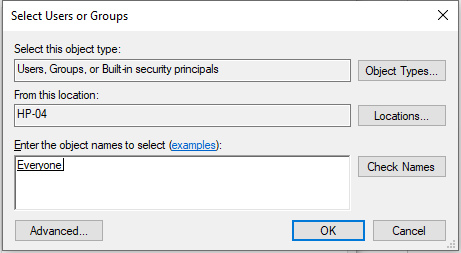
- Click Everyone from the Group or user names: box and check all the checkboxes under Allow.
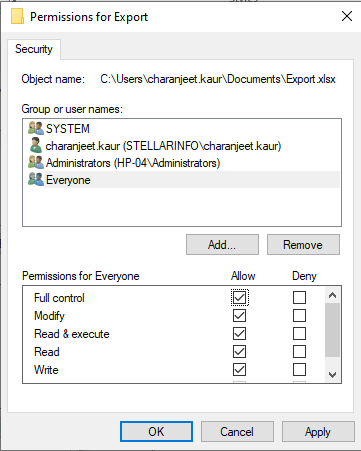
- Click on Apply and then OK.
Now try to open the Excel file. If you’re still getting the Excel file cannot open error, use the following workaround.
Workaround 3 – Recover Unsaved Workbook
If the ‘Excel file extension not valid error’ occurs when attempting to open an unsaved workbook, do the following to recover the unsaved workbook:
- In Excel, click File.
- From the Info screen, under Manage Versions, click Recover Unsaved Workbooks.
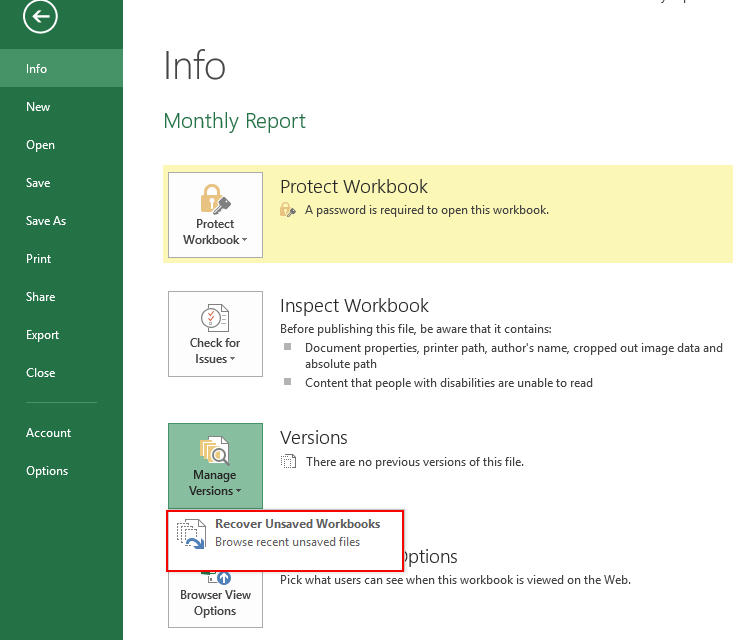
Excel will list any unsaved files. Try opening the file and save it. If this doesn’t work, skip to the next workaround.
Workaround 4 – Repair the Workbook
If none of the above workarounds has worked for you, chances are that the Excel file has become corrupted. Try to repair the file using the Excel inbuilt ‘Open and Repair’ utility by following these steps:
- In your Excel application, click on File > Open.
- In the ‘Open’ dialog box that pops-up, select the Excel file you want to repair and click the arrow next to the Open button.
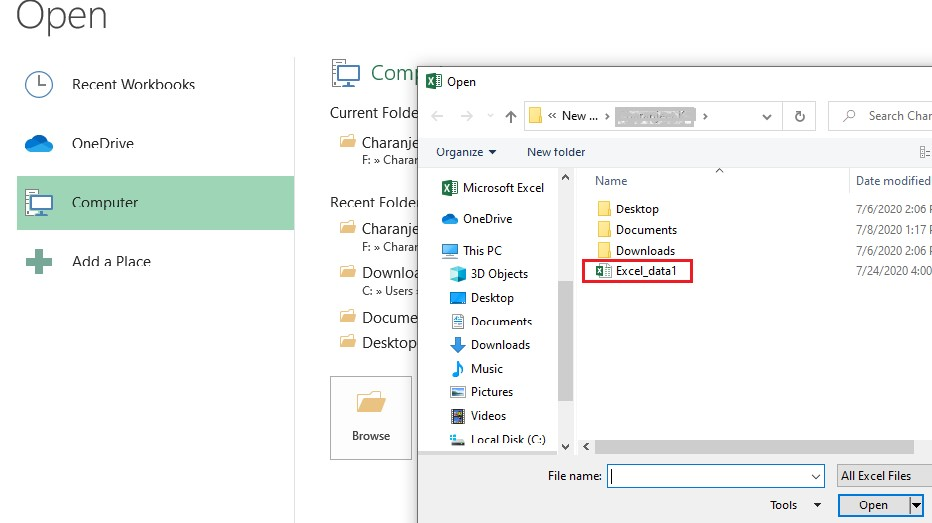
- From the dropdown list, select Open and Repair.
- Excel will ask you to attempt to repair the file or extract data from it. Click Repair to retrieve maximum data. If the Repair option fails, click on Extract Data to recover the data without formulas and values.

If the ‘Open and Repair’ utility doesn’t help fix the corrupted file and/or recover the data, use an Excel repair tool such as Stellar Repair for Excel to regain access to your file and its data.
Stellar Repair for Excel software can help repair severely corrupted XLS and XLSX files. Also, it helps recover all the file components, including tables, pivot tables, cell comments, charts, chart sheets, images, formulas, etc., without impacting the original structure of the Excel file.
To learn how the software works, read this: How to repair corrupt Excel file using Stellar Repair for Excel?
Conclusion
You may encounter the error ‘Excel cannot open the file because the extension is not valid’ when opening a workbook with a different file format or an incorrect file extension. Also, the error may occur if the Excel file has turned corrupt. This article has covered some of the most effective workarounds to resolve the error. But if nothing works, you can try to repair the Excel file and retrieve its data using the Stellar Repair for Excel software.
Fix the Too many different cell formats Error in Excel?
Excel has set a limit on the number of unique cell formats within a workbook. Excel 2003 allows up to 4000 different cell format combinations, whereas Excel 2007 and later versions allow a maximum of 64000 combinations. When this limit exceeds, you may encounter errors, such as “Too many different cell formats”. It can prevent you from inserting or modifying workbook rows or columns. Sometimes, it prevents you to copy and paste the content within the same or different workbooks. This error may also occur due to various other reasons.
You can encounter the “Too many different cell formats” error due to the below reasons:
- Formatting is missing in the workbook.
- Size of your Excel file has increased due to excessive use of complex formatting (conditional formatting).
- Workbook contains a large number of merged cells.
- There are multiple built-in or custom cell styles.
- Excel workbook is corrupted.
- The unused styles are unexpectedly copied to new workbooks (when moving or copying a worksheet from one to another).
- Workbooks contain multiple worksheets with different cell formatting.
Methods to Fix the “Too many different cell formats” Error in Excel
First, check that your Excel application is up-to-date. It helps in preventing duplicate styles in workbooks. If the error persists, then follow the below methods:
Method 1: Simplify the Workbook Formatting
You can face the error in Excel - Too many different cell formats, if the size of your Excel file has increased due to excessive or unnecessary formatting. You can try to simplify the formatting of the affected workbook. While reducing the number of formatting combinations, you can follow the simplifying guidelines, such as using a standard font and applying borders consistently. Follow the below steps to remove unnecessary formatting in your worksheet:
- First, open the affected worksheet.
- Now, use the shortcut key (Ctrl+A) to select all the cells.
- In the Excel ribbon, navigate to the Home tab and click Clear.

- Then, select the Clear Formats option.
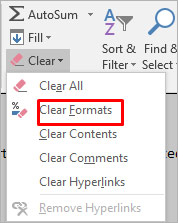
The above steps will remove all unnecessary formatting from the selected cells, thus reducing the number of cell formats. Besides this, you can try removing the cell patterns (if any) or use cell styles to remove unnecessary formatting in the workbook.
Method 2: Remove Conditional Formatting
Conditional formatting is also one of the reasons behind the “Too many different cell formats” error. It usually occurs if you have applied multiple rules to various cells or cell ranges within a workbook. Each rule has its own formatting settings. If you’ve applied a large number of conditional formatting to cells, it can increase the number of unique cell formats. You can check and remove the unnecessary conditional formatting. Here are the steps to do this:
- Open the Excel file in which you are getting the error.
- Go to the Home tab and locate Conditional Formatting.
- Select Manage Rules.
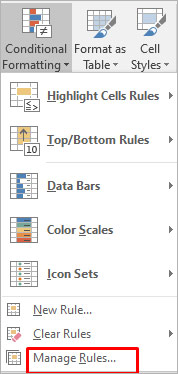
- The Conditional Formatting Rules Manager wizard is displayed. You can check the formatting rules and delete the unnecessary rule by clicking on the Delete Rule option.
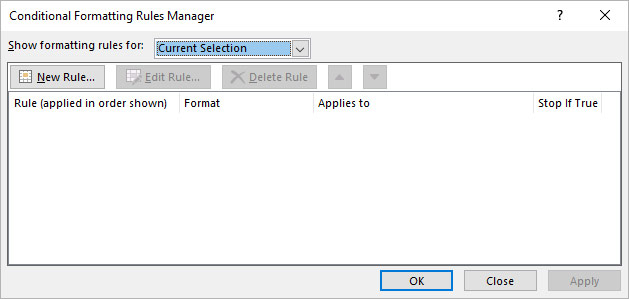
Method 3: Repair your Excel Workbook
Corruption in the Excel workbook can also cause the “Too many different cell formats” error. You can try the Microsoft inbuilt utility to repair the file. Follow these steps to use this utility:
- Open your Excel application. Go to File > Open.
- Click Browse to choose the affected workbook.
- The Open dialog box will appear. Click on the corrupted file.
- Click the arrow next to the Open button and then select Open and Repair.
- You will see a dialog box with three buttons - Repair, Extract Data, and Cancel.

- Click on the Repair button to recover as much of the data as possible.
- After repair, a message is displayed. Click Close.
If the Open and Repair utility does not work or fails to repair the corrupted Excel file due to any reason, then you can use Stellar Repair for Excel to repair the Excel file. It is a simple-to-use third-party Excel repair tool with an intuitive UI that enables anyone to use it without much effort. The tool can help in fixing the “Too many different cell formats” error. It does so by repairing the Excel (XLS/XLSX) file and recovering all the components, including damaged cell style, without impacting the original formatting. You can download the software’s demo version and install it to check how it works.
Method 4: Save the Excel File to a Binary Workbook (.xlsb) Format
You can also get the “excel too many cell formats” error if the size of the spreadsheet is too large. You can try saving the Excel file in binary (.xlsb) format to reduce the Excel file size. Here’s how to do so:
- In Excel, navigate to File > Save As.
- Select Excel Binary Workbook (*.xlsb) in the Save as type dialog box.
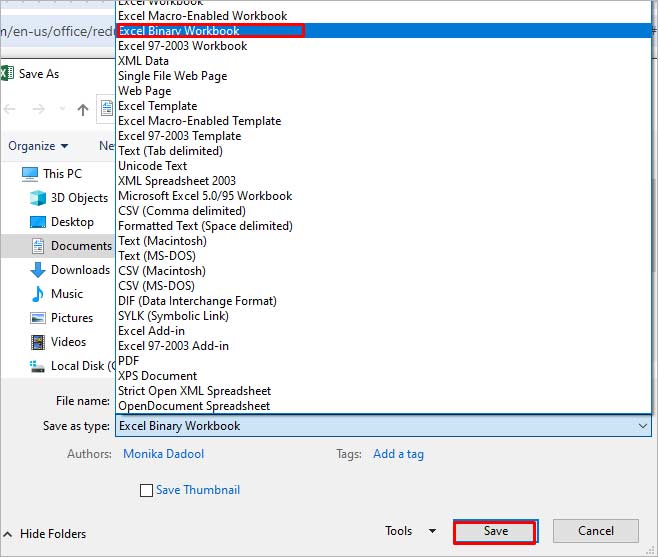
- Click Save.
Some Additional Solutions
Here are some additional methods you can try to fix the issue:
1. Check and Fix the Un-used Style Copy Issue
Many users have reported encountering the “Too many different cell formats” error when moving or copying the content of a workbook from one Excel to another and the unused styles being copied from one workbook to another. Microsoft has released a hotfix package which contains a fix for this issue. You can install this hotfix package (2598143 ) to resolve the issue.
2. Use Clean Excel Cell Formatting Option
You can check and enable the Excel cell formatting option to fix the “Too many cell formats” issue. This option will help you remove the excess formatting in your workbook. To locate this option, click on the Inquiabove steps willre tab. If you fail to see the Inquire tab, then check if the Inquire option is enabled in the Excel Com Add-ins settings.
3. Clean up Workbooks using Third-Party Tools
The “Too many different cell formats” issue can occur if your workbook contains a large number of unnecessary styles, as mentioned above. You can use third-party tools, such as XLStyles Tool or Remove Styles Add-in to clean up workbooks recommended in Microsoft Guide. However, Microsoft takes no guarantee of these tools.
Closure
If you’re getting the “Too many different cell formats” error in Excel, try the methods discussed in this post to resolve it. You can simplify the formatting by following standardized guidelines and clearing all the unnecessary conditional formatting. If the error has occurred due to corruption in Excel file, then you can use Stellar Repair for Excel to repair the Excel file. It is an advanced tool that can repair Excel worksheet and recover all its objects without losing the original formatting.
Ways to Fix Personal Macro Workbook not Opening Issue
Many users have reported encountering issues while accessing personal macro workbook, such as personal macro workbook not opening, personal macro workbook not loading automatically, Excel personal macro workbook keeps getting disabled, etc.
Such issues may arise due to a problem with the directory where the personal workbook is stored. However, there are various other reasons that may lead to such issues. Below, we’ll discuss the reasons behind the personal macro workbook not opening issue and the solutions to troubleshoot and fix the issue. But before proceeding, let’s understand why personal macro workbook is used.
Why Personal Macro Workbook is used?
You can access macros in a specific Excel workbook. However, when you need to use the same macro in other Excel worksheets, then you can create a personal macro workbook. A personal macro workbook (Personal.xlsb) is a hidden workbook that is used to store all macros. It makes your macros available every time you open Excel.
Causes of Personal Macro Workbook not Opening Issue
You may encounter personal macro workbook is not opening issue when attempting to record macros. Some possible causes behind such an issue are:
- Personal macro workbook is stored at an untrusted location
- Location of xlsb is changed
- Personal macro workbook is hidden
- Personal macro workbook becomes corrupted
- Disabled items in add-ins
- Workbook is Read-only
Methods to Fix the “Personal Macro Workbook not Opening” Issue
Follow the given methods to fix the personal macro workbook is not opening issue:
Method 1: Check the Path of Personal.xlsb
The personal macro workbook (Personal.xlsb) file is stored in XLStart folder. It opens automatically when you open your Excel application. However, sometimes it fails to load automatically. It usually occurs when you try to open the file from an incorrect path. You can check the path of Personal.xlsb by following these steps:
- Open the workbook.
- Click on the Developer tab.

- Press Alt + F11 to open Visual Basic Editor.
- Go to View > Immediate Window.
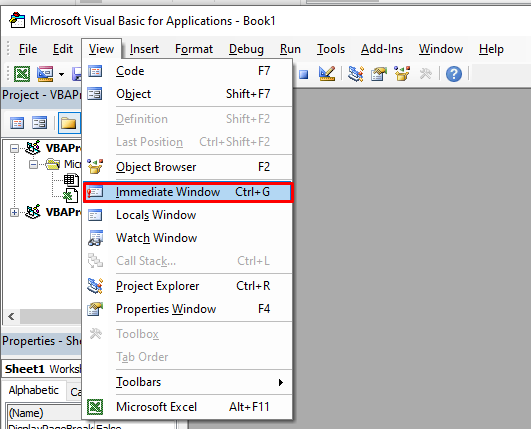
- In Immediate Window, type the following code to know the location of the workbook:
?thisworkbook.path.
- Then, hit Enter.
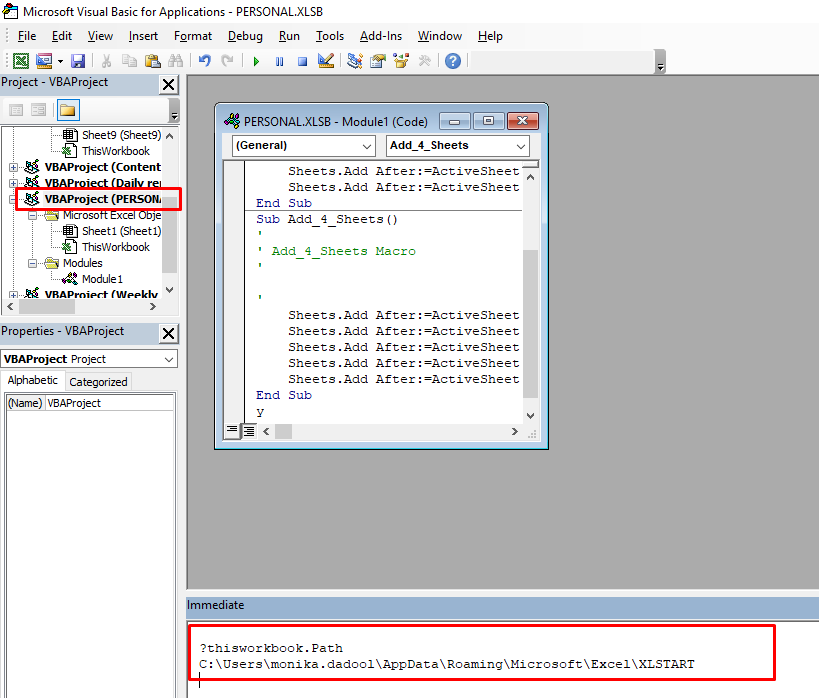
- You will see the path of the personal macro workbook.
- Copy the path and paste it into Quick Access field in File Explorer.

Method 2: Unhide Personal Macro Workbook
If personal macro workbook is hidden, you may unable to see and open the Personal.xlsb file. To unhide the personal Macro workbook, follow the below steps:
- In Microsoft Excel, go to View and then click Unhide

- The Unhide dialog box is displayed. Click PERSONAL and then OK.
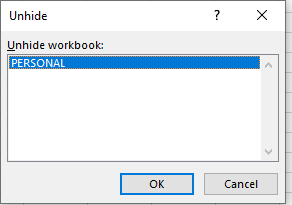
Method 3: Enable the Macro Add-ins
You may unable to open the previously recorded macros in your personal macro workbook if the macros are disabled. To check and enable the items, follow these steps:
- Go to File > Options.
- In Excel Options, click on the Add-ins
- Select Disabled Items from the Manage section and click on Go.
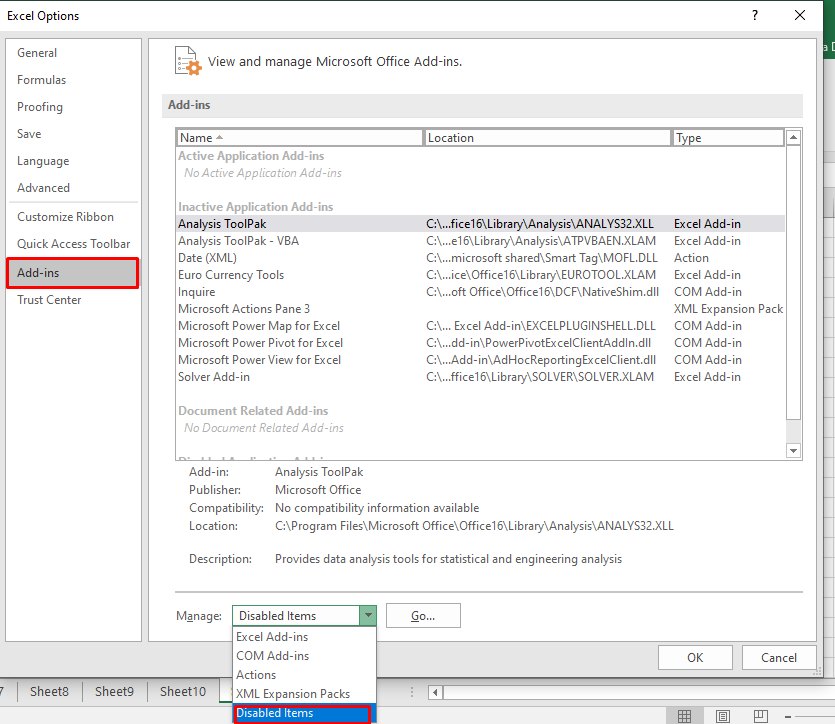
- The Disabled Items dialog box appears. Click on the disabled item and then click Enable.
Method 4: Change the Trusted Location
You may encounter the “personal macro workbook not opening” issue if the Personal.xlsb file is stored at an untrusted location. You can check and modify the path of XLSTART folder using the Trust Center window. Here are the steps:
- Open MS Excel. Go to File > Options.
- Click Trust Center > Trust Center Settings.
- In the Trust Center Settings dialog box, click on Trusted Locations.
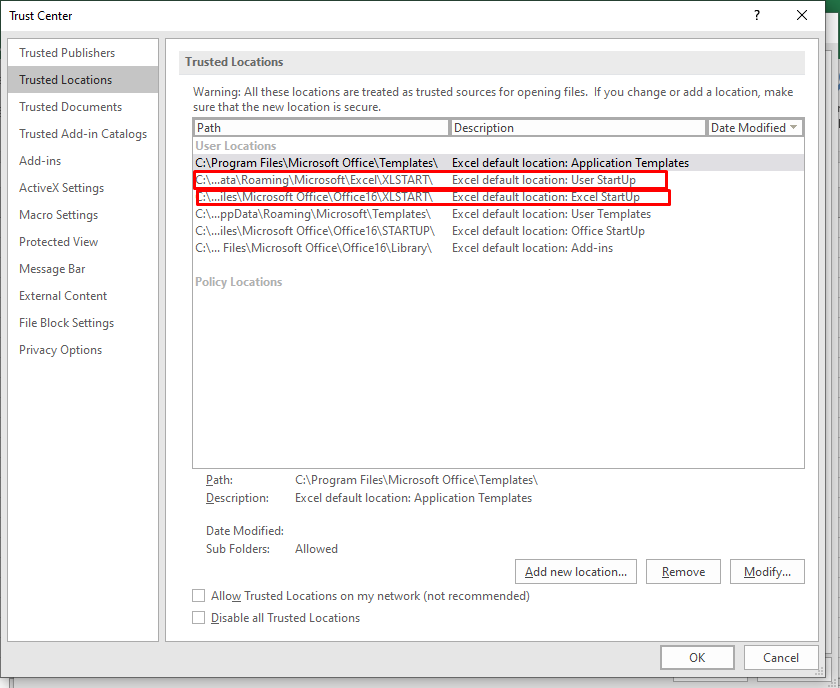
- Verify the path of the XLSTART If it is untrusted or there is any issue, then click Modify and then click OK.
Method 5: Repair your Excel File
You may fail to open personal macro workbook if it is corrupted. To repair the corrupt workbook, you can use the built-in Open and Repair utility in MS Excel. To use this tool, follow these steps:
- Open your Excel application.
- Click File > Open.

- Browse to the location where the corrupted file is stored.
- In the Open dialog box, select the corrupted workbook.
- From the Open dropdown list, click Open and Repair.
The dialog box appears with the Repair and Extract buttons. Click Repair to retrieve all possible data or the Extract option to recover the data without formulas and values.
If the Open and Repair utility fails to repair the corrupted Excel workbook, then you can use a professional Excel repair tool, such as Stellar Repair for Excel. It can easily repair severely corrupted Excel (XLSX and XLS) files and recover all the components. You can download the free trial version of the tool to preview the recoverable data.
## **Closure**This article discussed the ways to fix the personal macro workbook not opening issue. In case you are unable to open the personal macro workbook because of corruption in the workbook, you can use the Open and Repair utility in MS Excel. If it fails, then you can use Stellar Repair for Excel to fix corruption in the Excel file and recover all its data with complete integrity.
Get Rid of corrupt Excel File
Summary: What to do when an Excel file is corrupted? This is a common question that is often asked by Microsoft Excel users. If you too are seeking an answer to this question, read the blog to learn about a few manual workarounds and a specialized Excel file repair tool to resolve the Excel file corruption issue.
An Excel file gets corrupted due to various reasons such as a virus/malware attack, sudden system shutdown when the Excel file is still open, power failure while working with an Excel spreadsheet, etc.
When Microsoft Excel detects corruption in a workbook, it attempts to repair the workbook by starting ‘File Recovery mode’.
Tip! If the file recovery mode doesn’t start, you may use the manual repair process or an Excel repair tool, such as Stellar Repair for Excel to repair a corrupted Excel file. The software can help you quickly retrieve contents from a damaged, corrupt, or inaccessible Excel file and restore the file to its original state.
There even exist a few manual tips that can be used to recover data from damaged MS Office Excel files.
## **Workarounds to Use When an Excel File is Corrupted**Note: Before carrying out any of the repair and recovery workarounds, it is advised that you must save a backup copy of the damaged file. This is to prevent your files from turning completely inaccessible in case the methods fail to give desired results.
Workaround 1: Use the Open and Repair Method
If MS Excel cannot repair a corrupted workbook automatically, you can try to do it manually. To do so, perform the following:
- Open the corrupt file, like you normally open any file, by clicking File > Open.
- Browse and locate the folder containing the corrupted document.
- When the Open dialog box is displayed:
- Select the Excel document.
- Click on the arrow present to the right side of the Open button and select Open and Repair option.

Figure 1 – Open and Repair Feature
If this doesn’t help repair the broken Excel file or you encounter Open and Repair does not work issue, proceed with the next workaround.
Tip! Try an alternative solution, i.e. Stellar Repair for Excel software to repair and recover corrupt Excel files (.xlsx or .xls) when the ‘Open and Repair’ method won’t work.
Workaround 2: Restore an Excel File with a Shadow Copy
If you’re a Windows 7 or Vista user, you can try restoring the corrupted spreadsheet by using a shadow copy (or a previous version). [Shadow copy](https://en.wikipedia.org/wiki/Shadow_Copy#:~:text=Shadow%20Copy%20(also%20known%20as,the%20Volume%20Shadow%20Copy%20service .) is basically a snapshot (backup copy) of computer files or volumes. The snapshot may contain an older version of your Excel file that has become damaged now. To find out, do the following:
- Launch File Explorer, and right-click the folder in which the file is saved.
- Choose Properties.
- Look for and click the Previous Versions tab. This will display a list of entries under Folder versions or File versions, going back a few days or weeks.
- Double-click one with a date when the file was accessible and could be read. Then, try to open its older version. If it opens, save the older version with a new name and execute the procedure with new file/folder entries.

Figure 2 – Volume Shadow Copy
You would have to repeat the process until you reach the point where the file became damaged. With this, you will get a baseline version of the file, but data may still have been lost.
Workaround 3: Test your Assumptions
If you receive a message saying “Excel file corrupted and cannot be opened”, you would probably believe it. However, there could be other reasons besides corruption that may cause Excel to throw this error message.
Your Office suite, which Excel is a part of, maybe having some primary issues in it causing problems while opening one Excel document. So, try opening another Excel file to check if the problem exists with all the files or just one.
If other Excel documents work correctly, it means that only the particular document is corrupt. On the contrary, if the issue is with your Office suite, repairing the current Office installation may help fix the issue. For this, perform these steps:
- Go to Control Panel and click Uninstall the Program.
- Choose Office.
- Click Change, and hit the Repair button.
You can reinstall the entire Office package. Once reinstalled, try to open the file to check if the issue has been fixed and the Excel file repaired.

Figure 3 – MS Office Repair
Workaround 4: Use Excel File Repair Tool
If the above manual solutions fail, use Excel repair software to successfully repair your damaged Excel workbook and recover all its data. Essentially, the software rebuilds damaged Excel workbook data at a granular level to recover every single object & all the original properties of the workbook.
Suggested Read: How to repair corrupt Excel files using Stellar Repair for Excel?
Why Use Stellar Repair for Excel Software?
- Repairs severely corrupted XLSX and XLS files.
- Can handle corrupt Excel files of any size.
- Demo version allows previewing recoverable Excel file items for free.
- Supports Microsoft Excel 2019 and all lower versions.
- Compatible with Windows 10 and lower versions.
- Tested and recommended by Microsoft Excel MVPs.
Final Word
When an Excel file is corrupted, it won’t open at all or you won’t be able to access all the file data. Such a situation can lead to unnecessary halts, impacting work productivity.
There are manual workarounds that may help fix the corrupt Excel file and recover its data, such as the ones covered in this blog. However, these solutions might not work in severe corruption cases and may require technical assistance. Also, they may result in some data loss.
To overcome the limitations of manual workarounds, it is recommended to go for a professional Excel file repair tool such as Stellar Repair for Excel . It helps repair corrupt Excel (XLS or XLSX) files and restores all worksheet data, such as the table, chart, chart sheet, cell comment, sort and filter, image, formula, etc. in a few simple clicks. Moreover, the software provides a free preview of the recoverable data with its demo version. You can check the preview to evaluate how the software works.
Repair Office 2016 Files (Word, Excel and PowerPoint)on Windows
If you frequently work with Microsoft Word (.docx), Excel (.xlsx), and PowerPoint (.pptx) files, then issues like file inaccessibility or corruption won’t be new to you.
Let’s discuss some common scenarios which may lead to corrupt MS Office 2016 files:
Scenarios behind Microsoft Office Files Corruption
Scenario 1 – Disruption during Data Migration
You decide to move Office files from your hard drive to other removable media. However, when you try to access the data within the files post-migration, you may find Word, Excel, and PowerPoint files showing gibberish characters. Due to a power surge, sudden system shutdown, and internal mechanical failure, the files may have turned corrupt.
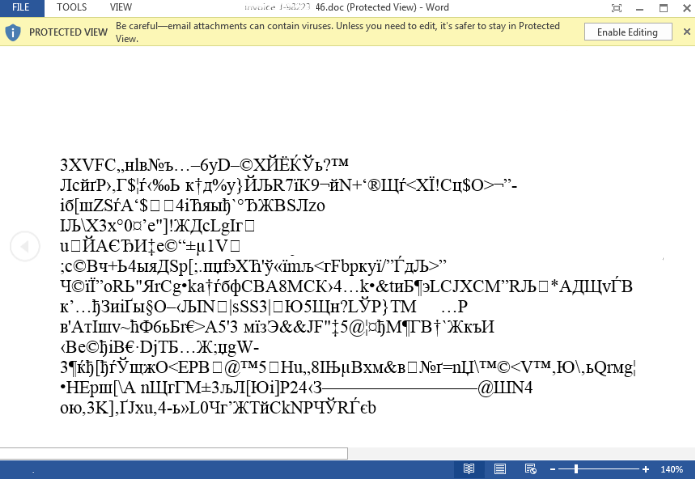
Figure 1- Microsoft Word file showing garbage characters
Scenario 2 – Office Files and Registry Entries Become Infected
When you open or use the Microsoft Office application, it crashes as soon as it opens. You assume that an add-in was causing the problem and restart the Office application without add-ins loaded, but the application still crashes. This may happen because of a virus infecting the Office files and registry values, thus leading to corrupt or damaged Office files.
Scenario 3 – Inaccessible or Lost Data
Suppose all your Office files are stored on a USB device, and you unplugged the device while it was still open in Windows. Now, when you attempt to open a Word or an Excel file, all the data is gone. Unsafe removal of USB or any other external storage device may corrupt the data inside your Office files or turn the file inaccessible.
How Can You Deal with Microsoft Office Files Corruption?
Here are a few solutions that can help you fix or repair Office 2016 Files Corruption:
Solution 1 – Use Microsoft in-built Repair Utility
Microsoft recommends using its in-built repair utility, ‘Open and Repair’, to fix corrupt Office files. Follow these steps to understand how you can use the utility to repair the corrupt Word, Excel, and PowerPoint files:
- Launch the MS Office application whose file you want to repair:
- To repair corrupt Word (.doc, .docx) files, launch MS Word
- To repair corrupt Excel files (.xls, .xlsx) files, launch MS Excel
- To repair corrupt PowerPoint (.ppt, .pptx) files, launch MS PowerPoint
- Click File, and then click the Open tab.
- Click Navigate to the location or folder where the Word, Excel, or PowerPoint file is stored.
- Select the corrupt file you want to repair by single-clicking on it, and then find the Open button and click on the drop-down menu next to it.
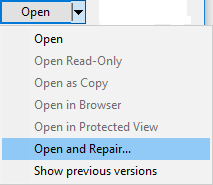
- From the drop-down menu, click the Open and Repair option and follow the subsequent instructions to repair Office 2016 files.
Solution 2 – Repair Office 2016 Installation
Try repairing the Office installation to fix the MS Office files. The steps to repair your Office installation may vary depending on the operating system you are using.
For Windows 7
- Open your PC’s control panel
- Click Programs
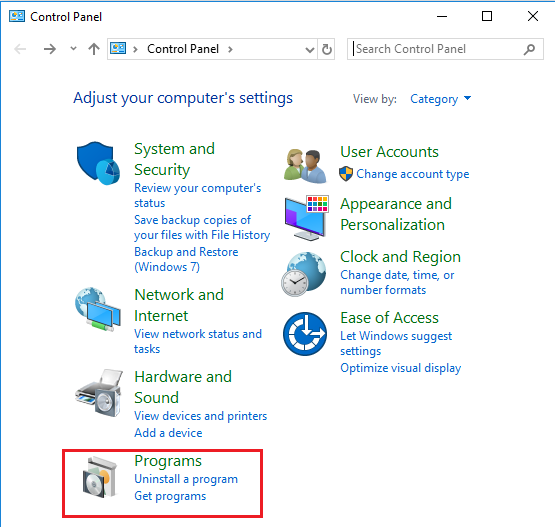
- Click Programs and Features, and then click Uninstall a program option
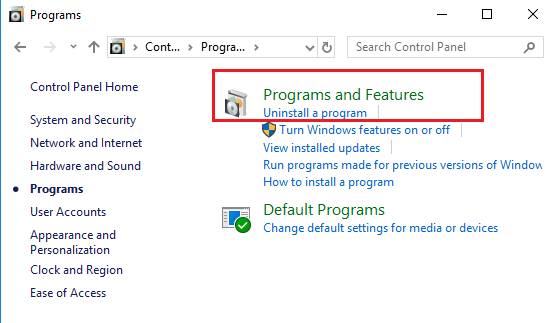
- Right-click on the Office application you want to repair, and then click Change
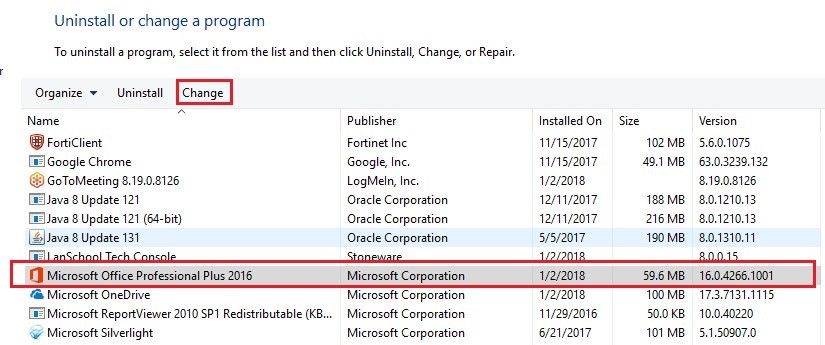
- Under Change your installation of Microsoft Office Professional Plus 2016, choose Repair and then click Continue.
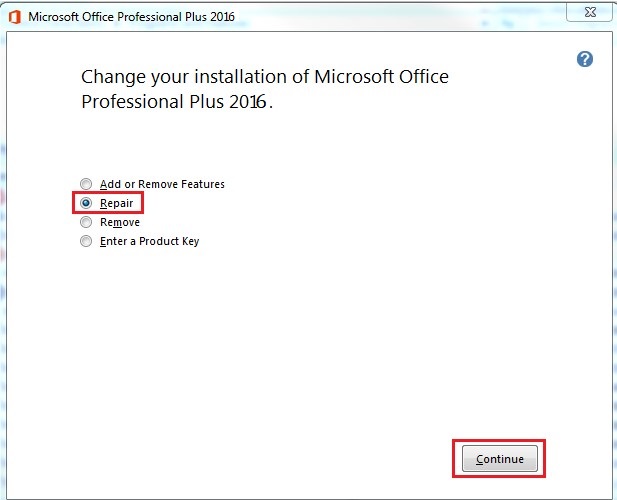
For Windows 10
- Right-click the Start button, and type in Apps & Features (For Windows 10)
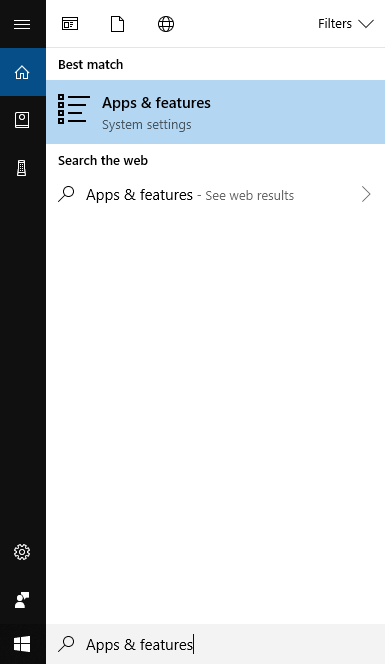
NOTE: This step will work for Windows 10/8/8.1/7 and Vista
- Click Programs from the window that opens, click on the MS Office product you want to repair, and then click on Modify

Note: Following the step will repair the entire Microsoft Office suite even if it contains only one application you want to repair such as an Excel or PowerPoint file. But, in case you have a standalone app installed, try to locate that application by name.
- Under Change your installation of Microsoft Office Professional Plus 2016, choose Repair, and then click Continue to initiate the repair process.

- Once the repair process completes, you’ll be prompted to restart your PC. Click Yes
Solution 3 – Use Stellar Toolkit for File Repair
Repair MS Office 2016 files by using Stellar Toolkit for File Repair . This software comprises four essential utilities that can help you repair corrupt MS Word, MS Excel, MS PowerPoint, and PDF files.
The toolkit helps repair corrupt Office 2016 and other version documents and files while maintaining the original file format, which is less likely achievable with inbuilt methods. Follow these steps to repair MS Office 2016 documents by using the Office file repair tool:
- Download and install Stellar Toolkit for File Repair.
- Launch the software.
- From the software’s main interface, select the MS Office file you want to repair.
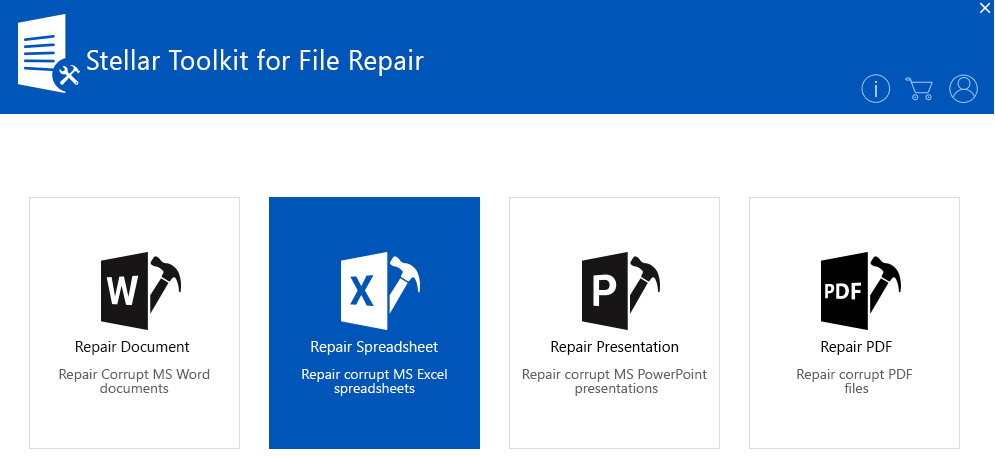
- From the window that pops up, select the corrupted file to be repaired.
Note: If you don’t know the exact location of corrupt office files or if they are large in number, you can locate the files by using the Find/Search option included in the software.
- After selecting the file, click the Scan button to initiate the repairing process.
- Once the scanning process is complete, all the recoverable information is displayed in the software’s left-hand panel. Click on any item to preview it before recovery.
- To save the repaired data, click the Save button, and enter a destination of your choice.
- Click OK.
Conclusion
This post outlined possible scenarios and their causes that may lead to corruption in MS Office 2016 files. It also emphasized how the inbuilt methods such as Open and Repair, and Repair Office Installation help to resolve the corruption issues. But these are not competent enough to resolve all the errors. With Stellar Toolkit for File Repair, you can resolve all sorts of corruption issues and recover data of Office 2016 files – Excel, Word, PPT, and PDF – in their original state.
How to fix Microsoft Excel not responding error and save your data
Summary: This guide helps you resolve Excel not responding and frequent Excel freeze issues in Excel on Windows 10. It mentions some effective solutions to repair Excel and resolve Excel is not responding problem. These solutions will also help you fix Excel crashing problem while working on the spreadsheet.
Similar to any other program, you may experience problems with Microsoft Excel while opening or working on a document. Sometimes, it may not start at all or freeze and display an error message such as ‘Excel is not responding’. When it happens, you may want to wait for the program to respond.

‘Microsoft Excel is not responding’ problem
Tip: If you are experiencing Excel not responding problem with a particular Excel file, it’s quite possible that the file is corrupt or partially damaged. And thus, leading to an Excel freeze or crash problem. Use Stellar Repair for Excel software to quickly repair and restore Excel (.xls/.xlsx) file in its original, intact form. You can download the free trial version of the software from the below link.
But if Excel doesn’t respond after a while and remains stuck, you need to force close the program from “Task Manager”. Now, this could be disastrous if happens while you are working on an important Excel document that took you hours to prepare. Force closing Excel due to such error can damage the Excel document and it may fail to open next time.
Why Excel is Not Responding?
Excel may stop responding, freeze, or crash suddenly due to several reasons. It can happen while saving a spreadsheet or opening an Excel document. It may also occur while editing or inserting images, graphs, etc. But usually, it occurs when the system crashes or shuts down abruptly while you are working on a document. Here’s an instance,
Suppose, you worked overnight on a critical document which is to be presented at a meeting the next day. This Excel spreadsheet includes critical graphs and charts, and much more. When you are about to save it, there is a power failure, and your system shuts down without warning. When the power is up, you restarted the system to check your Excel. To your dismay, a message pops up – “Excel Crashed” or “Microsoft Excel not responding”.
This could be frustrating. However, there is no need to despair as there are solutions to not just overcome this error but other corresponding issues such as Excel freezing, hanging, crashing, etc. Below is an infographic that quickly briefs all the possible solutions to fix Excel not responding error.
Solutions to Fix ‘Microsoft Excel is not responding’ Error
Follow the solutions discussed below in the given order to fix Excel freezing and hanging issues.
Solution 1: Open Excel in Safe Mode
If Excel is not working as intended and frequently stops responding, you may try to start Excel in Safe Mode. It is a common DIY way to fix ‘Excel is not responding’ problem.
In Safe Mode, Excel starts with only essential services, bypasses certain functionalities and doesn’t load the add-ins, which might be the reason behind the error in MS Excel . To open and troubleshoot Excel in Safe Mode:
- Press Windows + R keys, type excel.exe /safe and press ‘Enter’ or click ‘OK’

MS Excel in Safe Mode
Open the Excel file and check if it still crashes. If not, the problem could be a faulty add-in or formatting and styling error.
Proceed to the next solution to check and fix the problem.
Solution 2: Check for Faulty and Unwanted Add-ins
In Microsoft Excel, there are two types of add-ins:
- COM add-ins
- Other Add-ins Installed as XLAM, XLA, or XLL File
Both types of add-ins can cause the freezing problem in Excel . Follow the steps below to disable unwanted and faulty add-ins:
- In Excel , click File and go to Options to open ‘Excel Options’ window
- Click Add-ins button to view and manage ‘Microsoft Office Add-ins’
- Uncheck required add-ins to disable them
- At this stage, you can also click the ‘Remove’ button to remove any unwanted add-ins

Disable COM Add-Ins
- Now enable an add-in and check the Excel performance. Observe Excel for not responding error or freezing problem
If Excel doesn’t freeze, enable subsequent add-in and then again use Excel to observe it. Repeat the steps until you find the faulty plugin, which is causing the problem.
Then remove it from Excel add-ins to resolve the problem.
Solution 3: Install the latest Windows and Office Updates
This problem may also occur if Windows and MS Office are not updated. Therefore, install the latest updates for both Microsoft Windows and Microsoft Office.
You can set the installation and update option to ‘Automatic mode’ in Windows. This will download and install critical updates for MS Office, which might fix the Excel performance issue. The steps to enable automatic updates are as follows:
- Go to Settings> Update & Security> Windows Update

Enable Automatic Windows updates
- Click Advanced options and enable all the toggle switches to automatically download and install updates for Windows and other Microsoft products

Update Microsoft Products
After update, restart Excel and check if the problem is resolved.
NOTE: From now on, MS Excel will also get the latest update consistently, without the need for manual intervention.
Solution 4: Check and Disable Anti-virus
Antivirus is important for device safety. However, if your antivirus conflicts with MS Office apps such as Excel, it could lead to Excel freezing and not responding errors.
To check if the problem is due to anti-virus, disable it and reopen the Excel document. Check if Excel performs well or if it still hangs.

Example of Antivirus conflict with Microsoft Excel
If the problem is resolved, contact your antivirus software provider for help to keep antivirus running without affecting the system and other programs such as MS Excel.
Solution 5: Change the ‘Default Printer’
Although it may seem irrelevant, changing the default printer is another easy and effective solution to overcome the error. Reason being, Excel communicates with the printer to find supported margins when we open an Excel sheet.
If Excel doesn’t find the supported margin, it may stop responding or crash. The steps to change the default printer are as follows:
- Open Control Panel on your Windows system
- Click Printer and Devices
- Right-click Microsoft XPS Document Writer to set it to the default printer

Change in Default Printer Setting
Reopen the Excel document to check whether the error occurs or not.
Solution 6: Repair Microsoft Office
A corrupt or damaged Microsoft Office can also cause the ‘Excel is not responding’ problem. You can resolve this by repairing the Microsoft Office files. The steps are as follows:
- Close all running MS Office programs
- Go to Control Panel on your Windows system
- Click Programs and then Programs and Features
- Select Microsoft Office and in the Microsoft Office window, click ‘Change’
- Then select the ‘Repair’ option and click ‘Continue’

Repair MS Office
This may take a while. After the repair is done, check your Excel program and file for the error.
Solution 7: Remove and Reinstall Microsoft Office
Sometimes, repairing MS Office may not work. In such a case, removing and reinstalling Microsoft Office can resolve the ‘Excel is not responding’ problem. To do so, follow these steps:
- Close all running MS Office programs
- Go to Control Panel on your Windows system
- Click Programs and then Programs and Features
- Right-click on Microsoft Office and choose Uninstall

Uninstall MS Office
Then run the MS Office installation setup to re-install MS Office on your system.
Solution 8: Repair Microsoft Excel (XLS/XLSX) file
In several situations, a corrupt or partially damaged Excel (XLS/XLSX) file is the cause of this error. In such a case, you can download and install Stellar Repair for Excel to repair the corrupt or damaged Excel file. By repairing the Excel file, you can resolve the Excel freezing error quickly without applying much efforts.
The steps to use the software for Excel file repair are as follows:
- Download, install and launch the Excel file repair software
- Browse and select the corrupt Excel file

- Click ‘Repair’ to start repairing the damaged Excel file
- After file repair, it provides a preview. Check your file

- Then click the ‘Save File’ option in the main menu
- You can either choose default location or browse a new folder location to save the repaired Excel file

- After repair, open the file in Excel and continue with your work

And keep Stellar Repair for Excel installed on your system. You never know when you might need this handy tool.
You may also refer to Microsoft support for more details on Excel not responding, hangs, freezes or stops working issues.
Conclusion
Now that the methods for fixing the ‘Excel is not responding’ error are before you, try all these and see which one works for you. If the cause of this error is a damaged or corrupt Excel file, only repairing the XLS/XLSX file can resolve the issue.
For this purpose, it’s recommended to use a reliable software such as Stellar Repair for Excel as it offers an easy-to-use interface, thereby making Excel file repair process a seamless experience.
The software recovers table, chart, chart sheet, cell comment, number, text, shared formulas, image, formula, sort and filter, and other objects. It also preserves worksheet properties, layout, and cell formatting. It can repair multiple XLS/XLSX files simultaneously and fix all Excel file corruption errors.
All these features extend the software capabilities beyond just fixing the ‘Excel not responding’ error.
- Title: Fix Excel 2013 formula not showing result | Stellar
- Author: Nova
- Created at : 2024-07-17 17:14:20
- Updated at : 2024-07-18 17:14:20
- Link: https://phone-solutions.techidaily.com/fix-excel-2013-formula-not-showing-result-stellar-by-stellar-guide/
- License: This work is licensed under CC BY-NC-SA 4.0.











